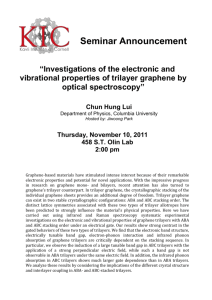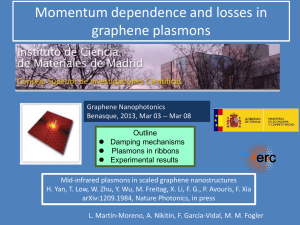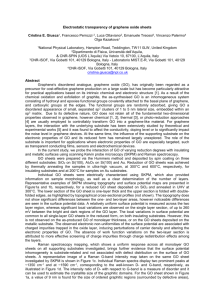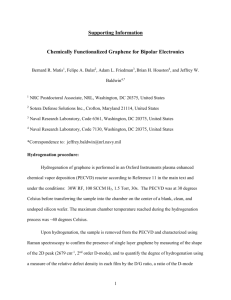Template for Electronic Submission to ACS Journals
advertisement
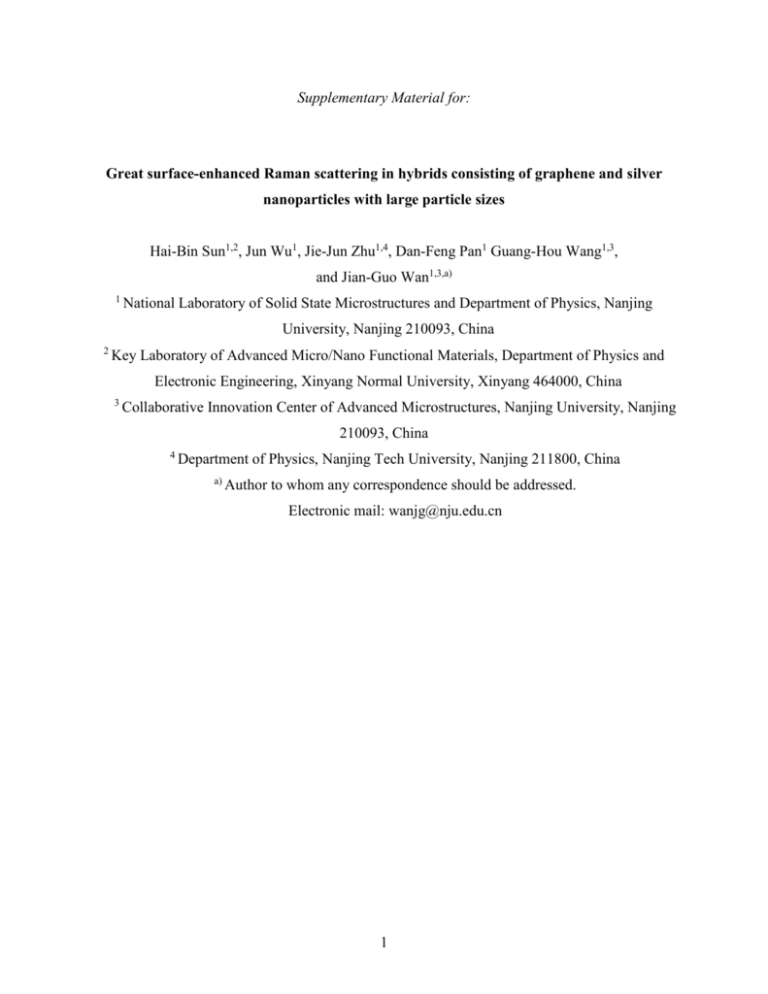
Supplementary Material for: Great surface-enhanced Raman scattering in hybrids consisting of graphene and silver nanoparticles with large particle sizes Hai-Bin Sun1,2, Jun Wu1, Jie-Jun Zhu1,4, Dan-Feng Pan1 Guang-Hou Wang1,3, and Jian-Guo Wan1,3,a) 1 National Laboratory of Solid State Microstructures and Department of Physics, Nanjing University, Nanjing 210093, China 2 Key Laboratory of Advanced Micro/Nano Functional Materials, Department of Physics and Electronic Engineering, Xinyang Normal University, Xinyang 464000, China 3 Collaborative Innovation Center of Advanced Microstructures, Nanjing University, Nanjing 210093, China 4 Department of Physics, Nanjing Tech University, Nanjing 211800, China a) Author to whom any correspondence should be addressed. Electronic mail: wanjg@nju.edu.cn 1 Characterization of graphene films. In this work, we synthesized AB-stacked bilayer graphene films on Cu foils by a nonisothermal atmospheric pressure chemical vapor deposition method.1 The Cu foils underneath the graphene films were removed by wet chemical etching. The graphene films were then transferred to SiO2/Si wafers or Cu grids for further characterization. To characterize the structures of the graphene films, we carried out various measurements, including high–resolution transmission electron microscopy (TEM), selected area electron diffraction (SAED), and Raman spectroscopy analyses. Figure S1. (a) High-resolution TEM image of the graphene film. (b) SAED patterns taken from the blue circled region in (a). (c) Profile plots of diffraction peak intensities along the arrows (from down to top) in (b). Figure S1(a) presents a high-resolution TEM image of the graphene film on a Cu grid. A twolayer folded edge is evident. Figure S1(b) shows the SAED patterns of the graphene taken from the blue circled region in Figure S1(a). The SAED patterns display a set of six-fold symmetry arrangement of carbon atoms. The intensities of the outer-order diffractions are almost twice as strong as those of the inner-order diffractions, indicative of AB-stacked bilayer graphene.2 2 Figure S2 (a) Optical microscope image of graphene film transferred onto SiO2/Si wafer. (b) Raman spectra taken from the black circled region in (a). (c) Enlarged 2D peak in (b). The asymmetric 2D peak is decomposed into four sub-bands with the Lorentz distribution. Figure S2(a) presents an optical microscope image of the graphene film transferred onto the SiO2/Si wafer. The film is continuous and uniform. We then randomly chose a region in the film to measure the Raman spectra. Figure S2(b) presents typical Raman spectra taken from the black circled region in Figure S2(a). The absence of a D peak (≈1350 cm-1) indicates that there are few defects in the graphene.3,4 The intensity ratio of the 2D peak (≈2655 cm-1) to the G peak (≈1590 cm-1) is I2D/IG ≈ 0.9, while the full width at half-maximum (FWHM) value of the 2D peak is 42 cm-1. More importantly, we find that the asymmetric 2D peak can be easily decomposed into four sub–bands with the Lorentz distribution, as shown in Figure S2(c). These characteristics are also clear signatures of AB-stacked bilayer graphene.5-7 According to the above measurement results, we confirm that the graphene film we prepared in this work is bilayered with an AB-stacked order. References: 1. H. B. Sun, J. Wu, Y. Han, J. Y. Wang, F. Q. Song, and J. G. Wan, J. Phys. Chem. C 118, 14655 (2014). 2. J. C. Meyer, A. K. Geim, M. I. Katsnelson, K. S. Novoselov, T. J. Booth, and S. Roth. Nature. 446, 60 (2007). 3. W. J. Zhao, P. H. Tan, J. Liu, and A. C. Ferrari. J. Am. Chem. Soc. 133, 5941 (2011). 4. A. C. Ferrari and D. M. Basko, Nat. Nanotechnol. 8, 235 (2013). 5. A. C. Ferrari, J. C. Meyer, V. Scardaci, C. Casiraghi,; M. Lazzeri,; F. Mauri, S. Piscanec, D. Jiang, K. S. Novoselov, S. Roth, and A. K. Geim. Phys. Rev. Lett. 97, 187401 (2006). 3 6. S. Lee, K. Lee, Z. Zhong. Nano Lett. 10, 4702 (2010). 7. L. X. Liu, H. L. Zhou, R. Cheng, W. J. Yu, Y. Liu, Y. Chen, J. Shaw, X. Zhong, Y. Huang, and X. F. Duan. Acs Nano. 6, 8241 (2012). 4


